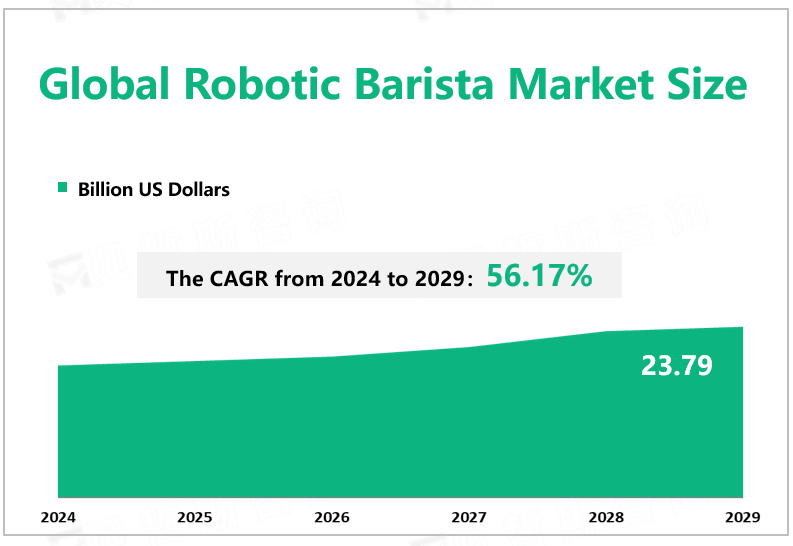Global Robotic Barista Market Overview
According to Global Market Monitor, the global robotic barista market size is expected to grow to $23.79 billion by 2029 with a CAGR of 56.17% from 2024 to 2029.
Coffee Consumption Has Increased.
Coffee is one of the most popular beverages in the world and the main source of caffeine. Coffee is still an important factor in daily life in society. Drinking coffee has become an integral part of the daily lives of millions of people around the world. As global labor costs rise, coffee shop operators' profits have fallen. However, Robotic Barista can reduce the time and improve the efficiency of coffee making, thus reducing the operating costs of the coffee shop. With cafes and bars in control of operating costs, the Robotic Barista industry is likely to grow.
Growing coffee consumption, increasing disposable income, changing consumer spending patterns, innovative packaging and increasing demand for ready-to-drink coffee, and specialty coffee beverages. Rapid urbanization, and the requirement to manage refreshments to manage current lifestyles, may help increase consumer interest in coffee. With the increasing demand for coffee and a fast-paced lifestyle, it will promote the development of the Robotic Barista industry.

Market SWOT
The coffee brewed by the same employee is different each time, and baristas are prone to errors when there are particularly many customers. In contrast, according to preset personal preferences, Robotic Barista will repeatedly copy various beverage characteristics to the slightest differences, and Robotic Barista has a fast work cycle. With AI capabilities, robotic baristas can gather the data they need without distracting from the main goal of serving coffee shop guests. Multitasking can satisfy customers while providing managers with the necessary evidence about consumer traffic, popular products, and more. In addition, the price of coffee made by Robotic Barista is equal to the cost of a portion supplied
at regular coffee spots (approximately $ 3-4 in the US). However, hiring human employees to complete the job involves indirect costs, including social security and insurance, payment of sick leave, labor compensation, etc. For automatic coffee bars, the only cost that needs to be considered is the maintenance cost. Due to the high reliability of the automation solution, the maintenance cost is usually small. In areas with high customer traffic (for example, airports), robotic baristas can help solve labor shortages and high turnover. Robot baristas can reduce costs and eliminate labor shortages, and they can also boost profitability in cafes.
|
S |
Increased demand for coffee Increasing disposable income and Rapid urbanization Technological progress and product innovation Increased downstream demand |
|
W |
Increased labor costs for producing Robotic Barista Fluctuation in raw material prices High R & D costs and up-front investment |
|
O |
Robot baristas can increase the profitability of cafes. Food Industry Automation, Internet of Things and 5G Development |
|
T |
Industry profit margin Channel promotion and construction Fierce competition from international companies |
We provide more professional and intelligent market reports to complement your business decisions.